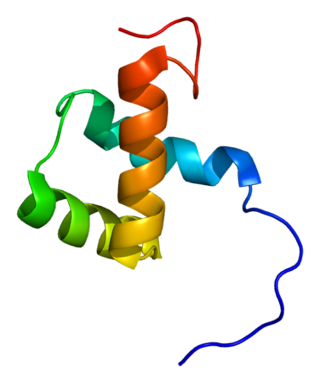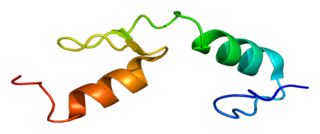Related Research Articles

A zinc finger is a small protein structural motif that is characterized by the coordination of one or more zinc ions (Zn2+) in order to stabilize the fold. It was originally coined to describe the finger-like appearance of a hypothesized structure from the African clawed frog (Xenopus laevis) transcription factor IIIA. However, it has been found to encompass a wide variety of differing protein structures in eukaryotic cells. Xenopus laevis TFIIIA was originally demonstrated to contain zinc and require the metal for function in 1983, the first such reported zinc requirement for a gene regulatory protein followed soon thereafter by the Krüppel factor in Drosophila. It often appears as a metal-binding domain in multi-domain proteins.

EGR-1 also known as ZNF268 or NGFI-A is a protein that in humans is encoded by the EGR1 gene.

Chromosome 19 is one of the 23 pairs of chromosomes in humans. People normally have two copies of this chromosome. Chromosome 19 spans more than 61.7 million base pairs, the building material of DNA. It is considered the most gene-rich chromosome containing roughly 1,500 genes, despite accounting for only 2 percent of the human genome.

Zinc finger and BTB domain-containing protein 16 is a protein that in humans is encoded by the ZBTB16 gene.

Zinc finger E-box-binding homeobox 1 is a protein that in humans is encoded by the ZEB1 gene.

Zinc finger protein 165 is a protein that in humans is encoded by the ZNF165 gene.

Zinc finger protein 40 is a protein that in humans is encoded by the HIVEP1 gene.

Zinc finger protein OZF is a protein that in humans is encoded by the ZNF146 gene.

Zinc finger protein 43 is a protein that in humans is encoded by the ZNF43 gene.

Zinc finger protein 74 is a protein that in humans is encoded by the ZNF74 gene. Schizophrenia susceptibility has been associated with a mutation in this protein.

Zinc finger protein 202 is a transcription factor first associated with breast cancer. It is a protein that, in humans, is encoded by the ZNF202 gene.

Zinc finger protein 10 is a protein that in humans is encoded by the ZNF10 gene.

Zinc finger and BTB domain-containing protein 32 is a protein that in humans is encoded by the 1960 bp ZBTB32 gene. The 52 kDa protein is a transcriptional repressor and the gene is expressed in T and B cells upon activation, but also significantly in testis cells. It is a member of the Poxviruses and Zinc-finger (POZ) and Krüppel (POK) family of proteins, and was identified in multiple screens involving either immune cell tumorigenesis or immune cell development.

Zinc finger protein 346 is a protein that in humans is encoded by the ZNF346 gene.

Zinc finger protein 7 is a protein that in humans is encoded by the ZNF7 gene.

Zinc finger protein 19 is a protein that in humans is encoded by the ZNF19 gene.

Zinc finger protein 22 is a protein that in humans is encoded by the ZNF22 gene.

Zinc finger protein 33B is a protein that in humans is encoded by the ZNF33B gene.

Zinc finger protein 34 is a protein that in humans is encoded by the ZNF34 gene.

Zinc finger protein 804A is a protein that in humans is encoded by the ZNF804A gene. The human gene maps to chromosome 2 q32.1 and consists of 4 exons that code for a protein of 1210 amino acids.
References
- ↑ "Human PubMed Reference:". National Center for Biotechnology Information, U.S. National Library of Medicine.
- ↑ "Entrez Gene: Zinc finger protein 385D" . Retrieved 2018-11-20.
- ↑ Guidi LG, Velayos-Baeza A, Martinez-Garay I, Monaco AP, Paracchini S, Bishop DV, Molnár Z (November 2018). "The neuronal migration hypothesis of dyslexia: A critical evaluation 30 years on" (PDF). The European Journal of Neuroscience. 48 (10): 3212–3233. doi:10.1111/ejn.14149. PMC 6282621 . PMID 30218584.